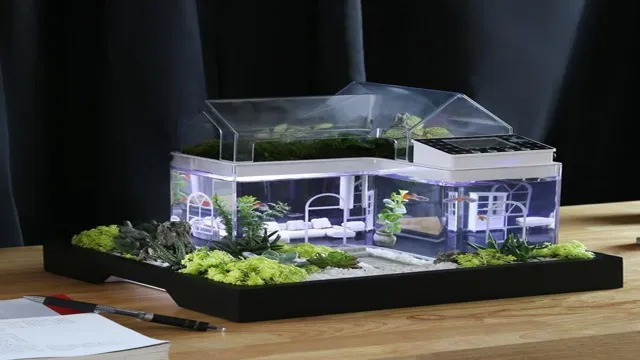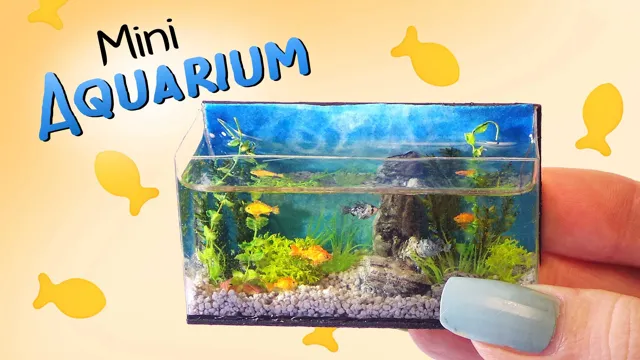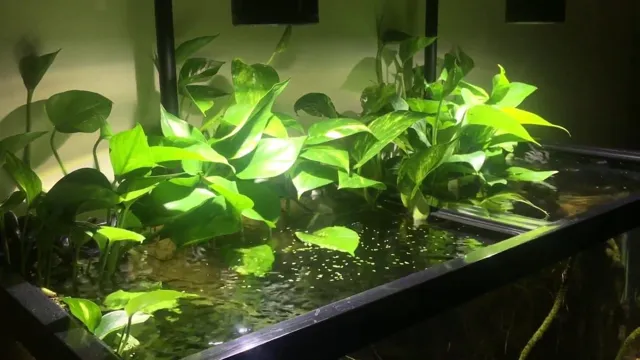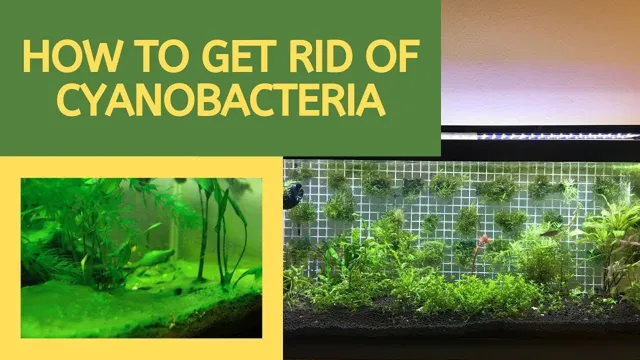If you’re a nature lover but don’t have enough space in your home to set up a large aquarium, why not try making a miniature aquarium? It’s a fun and creative way to bring nature indoors, and it doesn’t take up too much space. A miniature aquarium can be made in any size or shape you desire, and it can be customized to fit your home decor. Plus, it’s a great way to introduce kids to the wonderful world of aquatic life.
In this blog, we’ll show you how to make your own miniature aquarium, including everything you need to get started and tips for keeping your fish healthy and happy. So, let’s dive in!
Materials Needed
To make a miniature aquarium, there are several materials you will need. The first is a container to hold the water and your fish. This can be a small glass vase or bowl.
You will also need small rocks or gravel to create a comfortable resting place for your fish. Next, you will need plants and decorations to make the aquarium feel more realistic. It’s important to choose plants that can survive in water, such as moss or miniature ferns.
For decorations, you can use small figurines, fake coral or even small pebbles. You will also need a small filter to keep the water clean and a heater to keep the water temperature stable. Choose a quality fish food to keep your fish healthy and happy.
Finally, you will need fish. Make sure to choose the right type of fish that will fit comfortably in your miniature aquarium. With these materials, you can easily create a beautiful miniature aquarium that provides a serene and calming atmosphere to your living space.
Glass Jar or Container
If you’re into DIY projects or are looking for cost-effective ways to store your food, using glass jars or containers can be a great option. Not only do they look aesthetically pleasing, but they are also reusable and eco-friendly. Before you start using these containers, you’ll need to gather some materials to ensure that they are functional and safe.
First, you’ll need to find glass jars or containers that suit your needs. You can purchase them from stores, or you can repurpose food jars to give them a new life. Next, you’ll need to clean them thoroughly to remove any residue or odors.
You’ll also need to find some labels or markers to help you identify the contents of each jar and the date they were stored. Finally, you may want to invest in a set of reusable lids to make opening and closing the jars more convenient. With these materials, you can store your food items safely and beautifully while minimizing your impact on the environment.

Small Rocks or Gravel
If you’re contemplating adding some small rocks or gravel to your landscape, there are a few materials you’ll need to get started. First and foremost, you’ll need to decide on the type and size of the rock or gravel you want to use. Pea gravel, for example, is a popular choice for walkways and driveways due to its small size and smooth texture.
Next, you’ll need a sturdy pair of work gloves, as handling rocks and gravel can be challenging on your hands. A wheelbarrow or other type of cart can also be helpful for transporting the rocks from one location to another. Finally, you’ll need a way to level the gravel or rocks once they’re in place, such as a rake or hand tamper.
By gathering these materials beforehand, you’ll be well-prepared to tackle your landscaping project and create a beautiful and functional outdoor space.
Aquatic Plants
Aquatic plants are great additions to any aquarium or backyard pond. These plants add beauty and improve water quality by absorbing excess nutrients, oxygenating the water, and providing shelter for aquatic life. To start your aquatic plant project, you will need a few materials.
The first and most crucial item is a container to hold your plants. This container should be large enough to house the plants you wish to cultivate and deep enough to allow for proper root growth. A nutrient-rich substrate, such as aquarium soil or clay, is also necessary to support plant growth.
You will also need a light source appropriate for your plants’ needs and a filtration system to maintain water quality. Other optional materials include fertilizers, CO2 systems, and water testing kits to ensure your plants thrive. With these materials and a little care, you can create a beautiful aquatic environment for yourself and your underwater friends.
Fish or Shrimp
If you’re looking to prepare a delicious seafood dish, deciding between fish or shrimp can be a tough choice. Fortunately, there are plenty of materials you can use to create a delectable meal regardless of your selection. For fish, ingredients like lemon, dill, and garlic can add a refreshing and tangy flavor to the dish.
Additional materials, such as breadcrumbs or panko, can create a crispy coating that is sure to satisfy your taste buds. On the other hand, shrimp can be paired with spices like chili powder or cumin to add a kick of heat. Ingredients like butter or olive oil can also be used to sauté the shrimp and create a rich, buttery flavor. (See Also: How to Make a Self Sustaining Saltwater Aquarium: A Step-by-Step Guide)
Whether you choose fish or shrimp, make sure to select fresh, high-quality seafood to ensure a tasty and healthy meal. Ultimately, the decision between fish or shrimp comes down to personal preference and unique dietary needs. So which will it be: fish or shrimp? The choice is yours!
Setting Up the Aquarium
When setting up a miniature aquarium, there are a few key steps you’ll need to follow to ensure your fish and plants are healthy and happy. First, choose an appropriate tank size and shape for your space and the type of fish you plan to keep. A rectangular tank is a great choice for beginners, as it provides plenty of swimming room and clear lines of sight for viewing.
Next, add a substrate layer to the bottom of the tank, such as gravel or sand, to create a natural environment for your fish and allow for beneficial bacteria growth. Before adding water, rinse the substrate thoroughly to remove any debris or contaminants. When filling the tank with water, use a dechlorinator to remove chlorine and other harmful chemicals.
Finally, add any decorations or plants to the tank, being sure to choose species that are compatible with your fish and won’t overcrowd the space. Voila – your miniature aquarium is ready for its aquatic inhabitants!
Clean the Container
Setting up an aquarium can be an exciting and rewarding experience, but it’s important to start with a clean container. Whether you’re using a new or used aquarium, it’s crucial to thoroughly clean it before introducing any fish or plants. Begin by rinsing the tank with warm water to remove any dust or debris.
Then, apply a scrubbing solution made of water and a non-toxic aquarium cleaner. Use a sponge or soft-bristled brush to scrub all the surfaces inside the tank, including the walls, corners, and decorations. Rinse the tank thoroughly with clean water and allow it to air dry.
Avoid using soap or cleaning products that contain chemicals, as they can be harmful to fish. By starting with a clean container, you’ll provide a healthy and safe environment for your aquatic pets to thrive.
Add Rocks or Gravel
When setting up an aquarium, adding rocks or gravel can be a great way to create a natural and visually appealing environment for your aquatic pets. These materials not only enhance the overall look of the tank, but they also provide a variety of benefits to your fish. Rocks and gravel serve as a substrate for beneficial bacteria, which can help to maintain a healthy ecosystem in your tank.
Additionally, they can provide hiding places for your fish, helping to reduce stress and improve their overall wellbeing. When choosing the right rocks or gravel for your tank, it’s important to consider the size and shape of your fish, as well as any specific needs they may have. With the right selection, adding rocks or gravel to your aquarium can be an easy and effective way to create a vibrant and healthy aquatic habitat.
Plant Aquatic Plants
When it comes to setting up an aquarium for your aquatic plants, there are several things to consider. You’ll need to choose the right substrate, light source, and filtration system to ensure your plants thrive. Once you have these basics down, it’s time to think about actually planting your aquatic plants.
One important thing to keep in mind is not to overcrowd your tank. While it might be tempting to fill every available space with plants, this can actually harm their growth. Instead, start with a few plants and give them ample room to spread and develop.
Another thing to consider is the type of plant you’re choosing. Some plants require specific water conditions or lighting, so be sure to research each plant before adding it to your tank. By taking these steps and giving your aquatic plants the care they need, you can create a beautiful and thriving underwater ecosystem!
Fill the Container with Water
When setting up your aquarium, the first step is to fill the container with water. But don’t just pour in any old water you find. You want to make sure the water is safe for your fish.
The best option is to use a water conditioner that removes any harmful chemicals and chlorine commonly found in tap water. Fill the aquarium slowly to avoid damaging any plants or decorations you may have added. It’s also important to ensure that the water is level to prevent any stress on the aquarium’s glass or seams.
As you’re filling the aquarium, consider the type of fish you’ll be adding and their specific water needs. Some fish, for example, require a lower pH level, while others prefer a higher one. Keeping an eye on the water temperature is also essential.
Overall, taking the time to properly fill and condition the water sets your aquarium up for success and ensures a healthy environment for your aquatic pets.
Introducing Fish or Shrimp
Are you looking for a unique and creative way to decorate your space? Why not try making a miniature aquarium? With the right materials and a little bit of creativity, you can create a beautiful underwater world in a small space. One important factor to consider is whether to add fish or shrimp to your aquarium. If you choose to add fish, make sure to select species that can thrive in a small tank and require minimal maintenance. (See Also: How to Make Root Tabs for Aquarium: Step-by-Step Guide and Tips)
On the other hand, shrimp can be a great choice for a miniature aquarium because they are small and easy to care for. Before adding any creatures to your aquarium, make sure to do plenty of research and ensure that you are providing them with the proper environment and care. With some patience and dedication, your miniature aquarium can become a stunning focal point in any room.
Choose Suitable Species
Fish or shrimp can be a great addition to your aquarium, but it’s important to choose a suitable species. Some fish prefer to live in schools, while others are solitary creatures. Some shrimp species are happy to spend their days alone, while others prefer the company of other shrimp.
It’s also important to consider the size of your tank, as different species require different amounts of space to thrive. Do your research and choose species that will be happy and healthy in your aquarium. Don’t be afraid to ask for advice from your local fish store or aquarium society – they will have knowledge and experience that can help you make the best decision for your setup.
By choosing the right species, you can create a beautiful and thriving underwater world that you and your fish or shrimp will enjoy for years to come.
Adding Fish or Shrimp into the Aquarium
Introducing fish or shrimp into your aquarium is an exciting step, but it’s important to take the necessary precautions to ensure a successful transition. Before introducing new inhabitants, make sure to research their specific needs and compatibility with existing aquatic life. It’s also essential to properly acclimate your new additions to their new environment.
This can be done by slowly adding small amounts of water from your aquarium to their transportation bag or container over a period of time, allowing them to adjust to the water chemistry and temperature differences. Additionally, it’s important to monitor your new additions closely for any signs of stress or illness and to monitor water quality levels to maintain a healthy and balanced ecosystem. Overall, introducing new fish or shrimp can be a fun and rewarding experience with proper planning and care.
Maintaining the Aquarium
Maintaining a miniature aquarium requires ongoing care and attention. Start by carefully selecting appropriate plants and fish for the size of your aquarium and ensuring that they are compatible with one another. Regular water changes are essential to maintain water quality and keep your fish healthy.
Use a water testing kit to monitor ammonia, nitrite, and nitrate levels, and adjust as needed. Also, clean the gravel and decorations periodically to remove debris and waste. Additionally, make sure the aquarium filter is functioning correctly, and replace or clean filter media as needed.
Finally, keep an eye on the water temperature and adjust as needed to maintain a stable, healthy environment for your fish and plants. By following these tips, you can create a beautiful and thriving miniature aquarium. So, now you know how to make a miniature aquarium, let’s start maintaining it to enjoy its beauty effortlessly!
Regular Water Change
Maintaining an aquarium can be a relaxing and enjoyable hobby, but it’s important to understand the necessary steps to keep your aquatic pets healthy. One crucial aspect is performing regular water changes. Fish and other creatures living in the aquarium release waste and debris, which can build up and lead to poor water quality.
Changing 10-15% of the water every 1-2 weeks removes these harmful substances and provides fresh water with essential nutrients. Neglecting to perform water changes can result in sickness or death for your fish. It’s essential to use a water conditioner to remove any chlorine or other harmful substances from tap water before adding it to the tank.
Remember, neglecting to change the water can be detrimental to the health of your aquatic creatures, so don’t forget to include this crucial habit in your regular aquarium maintenance routine.
Feeding the Fish or Shrimp
Maintaining your aquarium is crucial for the health and well-being of your fish or shrimp. One important aspect of this is feeding them properly. It might seem simple, but feeding your aquatic pets requires careful consideration and expertise.
Overfeeding can cause a range of health problems like bloating, constipation, and even death. On the other hand, underfeeding can lead to malnutrition and stunted growth. The key is to feed your fish or shrimp the right amount of food at appropriate times.
Depending on the type of Aquarium, and the species that you have, the feeding schedule might vary. It’s important to research and understand the dietary needs of your specific fish or shrimp species. Providing a balanced diet with a variety of food options can help keep your pets healthy, and it’s also a good idea to regularly monitor their feeding habits to ensure they are eating well.
With the right approach to feeding and caretaking, you can enjoy a vibrant and thriving aquatic community in your aquarium. (See Also: How to Get an Aquarium Internship: Tips and Tricks for Landing Your Dream Opportunity)
Cleaning the Aquarium
Maintaining your aquarium should be a top priority if you want your fish to thrive and live in a healthy environment. One of the most important aspects of aquarium maintenance is cleaning it regularly. The buildup of waste, uneaten food, and other debris can quickly become a haven for harmful bacteria, fungus, and parasites.
It can also lead to poor water quality which can have disastrous effects on your fish’s health. To prevent this, it’s best to clean your aquarium once a week. You can start by siphoning out 10-20% of the water with a siphon hose and replacing it with fresh water treated with a water conditioner.
Use an algae scraper to remove any algae buildup on the glass, and a gravel vacuum to remove debris from the substrate. Lastly, wipe down the exterior of the tank with a clean cloth. With regular aquarium cleaning and maintenance, you can create a safe and healthy environment for your fish to thrive!
Checking Water Parameters
Maintaining a healthy aquarium requires regular water testing to ensure proper water parameters. Checking the pH, ammonia, nitrite, and nitrate levels is crucial to prevent fish illness and maintain a clean environment. It’s essential to use reliable test kits and follow the instructions carefully to obtain accurate results.
It’s recommended to test the water weekly, especially after water changes. If you notice any significant changes in the parameters, take immediate action to correct them, such as adding water conditioner or performing a partial water change. Remember, the water quality directly affects the health and well-being of your aquatic pets, so keeping up with regular testing and maintenance is key to a thriving aquarium.
Conclusion
In conclusion, creating a miniature aquarium is not only a fun and creative DIY project, but it’s also a way to bring a unique piece of nature into your home or office. With just a few simple materials and a bit of artistic flair, you can design a beautiful aquatic wonderland that will bring a sense of calm and relaxation to any space. So don’t be afraid to dive in and get started – with a little bit of patience and imagination, you’ll be amazed at the beautiful miniature world you can create!”
FAQs
What materials do I need to make a miniature aquarium?
You will need a glass container, aquarium gravel, aquatic plants, small decorative figurines, and a small water pump.
How do I create a realistic underwater environment in my miniature aquarium?
Use a variety of aquatic plants and select figurines that mimic elements you would find in a real aquarium, such as coral and rocks. Also, consider adding a small water pump to create currents and mimic the movement of water.
Is it safe for aquatic life to be kept in a miniature aquarium?
It is not recommended to keep live fish or other aquatic animals in a miniature aquarium due to the limited space and potential lack of proper filtration. Instead, select miniature figurines of aquatic animals to create a realistic display.
Can I use tap water in my miniature aquarium?
It is not recommended to use tap water as it may contain chlorine and other chemicals. Instead, use distilled or aquarium-safe water.
How often should I clean my miniature aquarium?
A miniature aquarium should be cleaned every 1-2 months. Remove any debris and algae, and replace the water and aquarium gravel as needed.
How do I maintain a healthy and balanced environment in my miniature aquarium?
Monitor the water pH and temperature regularly and add appropriate aquatic plant fertilizers. Also, consider adding a small water pump to promote circulation and filtration.
What are some creative ideas for decorating a miniature aquarium?
Incorporate unique and interesting figurines, such as sunken ships or treasure chests, and use colorful and diverse aquatic plants to create a vibrant underwater scene.







